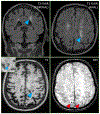Treatment Approaches to Lacunar Stroke
- PMID: 31151838
- PMCID: PMC7456600
- DOI: 10.1016/j.jstrokecerebrovasdis.2019.05.004
Treatment Approaches to Lacunar Stroke
Abstract
Lacunar strokes are appropriately named for their ability to cavitate and form ponds or "little lakes" (Latin: lacune -ae meaning pond or pit is a diminutive form of lacus meaning lake). They account for a substantial proportion of both symptomatic and asymptomatic ischemic strokes. In recent years, there have been several advances in the management of large vessel occlusions. New therapies such as non-vitamin K antagonist oral anticoagulants and left atrial appendage closure have recently been developed to improve stroke prevention in atrial fibrillation; however, the treatment of small vessel disease-related strokes lags frustratingly behind. Since Fisher characterized the lacunar syndromes and associated infarcts in the late 1960s, there have been no therapies specifically targeting lacunar stroke. Unfortunately, many therapeutic agents used for the treatment of ischemic stroke in general offer only a modest benefit in reducing recurrent stroke while adding to the risk of intracerebral hemorrhage and systemic bleeding. Escalation of antithrombotic treatments beyond standard single antiplatelet agents has not been effective in long-term lacunar stroke prevention efforts, unequivocally increasing intracerebral hemorrhage risk without providing a significant benefit. In this review, we critically review the available treatments for lacunar stroke based on evidence from clinical trials. For several of the major drugs, we summarize the adverse effects in the context of this unique patient population. We also discuss the role of neuroprotective therapies and neural repair strategies as they may relate to recovery from lacunar stroke.
Keywords: Cerebrovascular diseases; cerebral small vessel disease; lacunar stroke; stroke.
Copyright © 2019 Elsevier Inc. All rights reserved.
Conflict of interest statement
Conflicts of Interest/Disclosures
The authors report no conflicts of interest or disclosures.
Figures




Similar articles
-
The Potential Impact of Neuroimaging and Translational Research on the Clinical Management of Lacunar Stroke.Int J Mol Sci. 2022 Jan 28;23(3):1497. doi: 10.3390/ijms23031497. Int J Mol Sci. 2022. PMID: 35163423 Free PMC article. Review.
-
Predictors of stroke recurrence in patients with recent lacunar stroke and response to interventions according to risk status: secondary prevention of small subcortical strokes trial.J Stroke Cerebrovasc Dis. 2014 Apr;23(4):618-24. doi: 10.1016/j.jstrokecerebrovasdis.2013.05.021. Epub 2013 Jun 22. J Stroke Cerebrovasc Dis. 2014. PMID: 23800503 Free PMC article. Clinical Trial.
-
Lacunar Stroke.2024 Mar 10. In: StatPearls [Internet]. Treasure Island (FL): StatPearls Publishing; 2025 Jan–. 2024 Mar 10. In: StatPearls [Internet]. Treasure Island (FL): StatPearls Publishing; 2025 Jan–. PMID: 33085363 Free Books & Documents.
-
European stroke organisation (ESO) guideline on cerebral small vessel disease, part 2, lacunar ischaemic stroke.Eur Stroke J. 2024 Mar;9(1):5-68. doi: 10.1177/23969873231219416. Epub 2024 Feb 21. Eur Stroke J. 2024. PMID: 38380638 Free PMC article.
-
Pre-Existing Cerebral Small Vessel Disease Limits Early Recovery in Patients with Acute Lacunar Infarct.J Stroke Cerebrovasc Dis. 2019 Nov;28(11):104312. doi: 10.1016/j.jstrokecerebrovasdis.2019.104312. Epub 2019 Aug 5. J Stroke Cerebrovasc Dis. 2019. PMID: 31395422
Cited by
-
Improving detection of cerebral small vessel disease aetiology in patients with isolated lobar intracerebral haemorrhage.Stroke Vasc Neurol. 2023 Feb;8(1):26-33. doi: 10.1136/svn-2022-001653. Epub 2022 Aug 18. Stroke Vasc Neurol. 2023. PMID: 35981809 Free PMC article.
-
Hip Osteoarthritis and the Risk of Lacunar Stroke: A Two-Sample Mendelian Randomization Study.Genes (Basel). 2022 Sep 3;13(9):1584. doi: 10.3390/genes13091584. Genes (Basel). 2022. PMID: 36140752 Free PMC article.
-
The role of biomarkers and neuroimaging in ischemic/hemorrhagic risk assessment for cardiovascular/cerebrovascular disease prevention.Handb Clin Neurol. 2021;177:345-357. doi: 10.1016/B978-0-12-819814-8.00021-4. Handb Clin Neurol. 2021. PMID: 33632452 Free PMC article.
-
Hypertension control after intracerebral hemorrhage among varying small vessel disease etiologies.Neurol Sci. 2024 Oct;45(10):4913-4921. doi: 10.1007/s10072-024-07560-2. Epub 2024 May 21. Neurol Sci. 2024. PMID: 38772978
-
Gut Microbiotic Features Aiding the Diagnosis of Acute Ischemic Stroke.Front Cell Infect Microbiol. 2020 Dec 21;10:587284. doi: 10.3389/fcimb.2020.587284. eCollection 2020. Front Cell Infect Microbiol. 2020. PMID: 33409158 Free PMC article.
References
-
- Moran C, Phan TG, Srikanth VK. Cerebral small vessel disease: a review of clinical, radiological, and histopathological phenotypes. Int J Stroke. 2012. January 24;7(1):36–46. - PubMed
-
- Arboix A, Marti-Vilalta JL. New concepts in lacunar stroke etiology: the constellation of small-vessel arterial disease. Cerebrovasc Dis. 2004;17 Suppl 1:58–62. - PubMed
-
- de Groot JC, de Leeuw FE, Oudkerk M, van Gijn J, Hofman A, Jolles J, et al. Cerebral white matter lesions and cognitive function: the Rotterdam Scan Study. Ann Neurol. 2000. February;47(2):145–51. - PubMed
-
- Pantoni L Cerebral small vessel disease: from pathogenesis and clinical characteristics to therapeutic challenges. Lancet Neurol. 2010. July;9(7):689–701. - PubMed
-
- Vermeer SE, Prins ND, den Heijer T, Hofman A, Koudstaal PJ, Breteler MMB. Silent Brain Infarcts and the Risk of Dementia and Cognitive Decline. N Engl J Med. 2003. March 27;348(13):1215–22. - PubMed
Publication types
MeSH terms
Grants and funding
LinkOut - more resources
Full Text Sources

